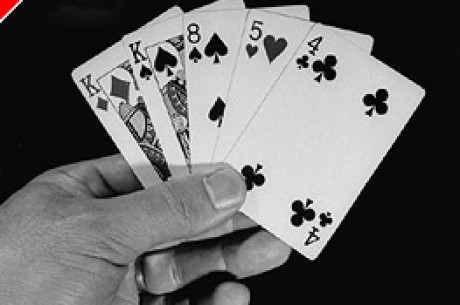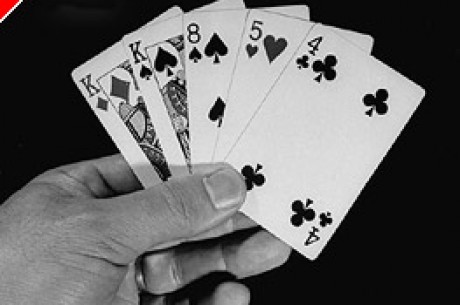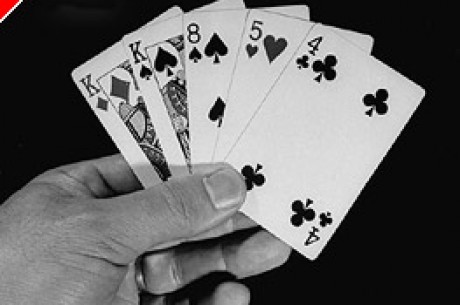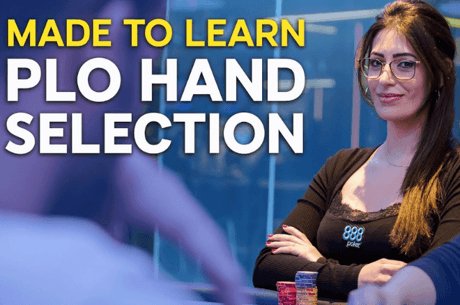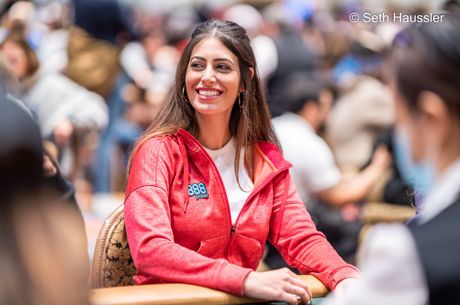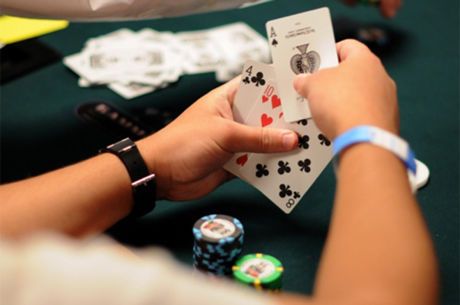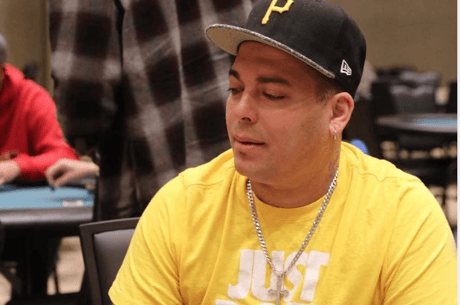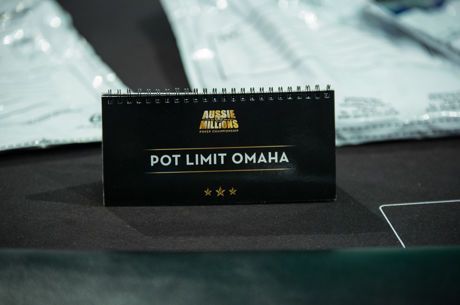Intro to Omaha - Pot Limit - A Hi/Lo Conundrum
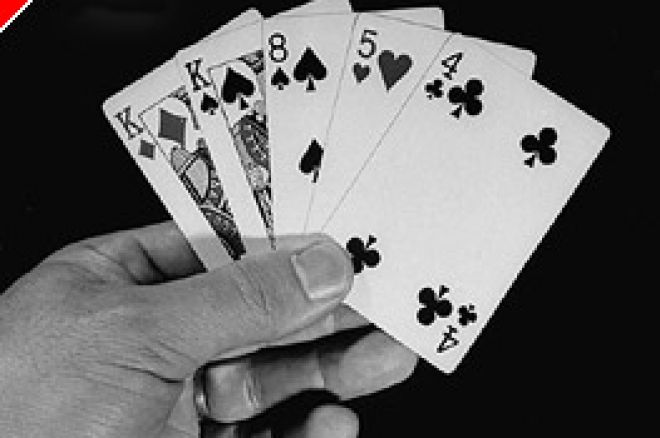
Tony is a regular on-line and card room player living in England. He mostly plays Texas Hold'em and Omaha (High and Split) at fixed, pot and no limit, at both cash and tournament tables.
Introduction
Last time, I described a few hands of pot limit Omaha Hi/Lo Split which I argued were successful because of the emphasis on pursuing hands with the best chance of winning the high pot.
What I want to look at this time is a puzzle that the player is frequently confronted with in this variation of the game. You may find yourself gunning for the high pot but how do you handle decisions when facing a big bet from your opponents when you do not know what pot they are betting at?
Put to the Test (in late position)
Playing on-line leaves you with nothing but a few basic clues about your opponents; namely, the time they take to make a betting decision, the size of any bet and maybe the things they type in the chat box if they are so inclined to interact.
However, in a game of Omaha Hi/Lo Split, you know that many players are fatally attracted to the low pot. This should contrast with your own game that requires you to demand some powerful options for making a strong high hand, or at the very least a good shout for both high and low hands with one of these at or near the nuts.
It is too easy for many players to launch into the betting after being dealt A2xx, A3xx or 23xx when the xx element is a collection of "nuts, bolts and washers" rather than the shiny silver pieces needed to challenge for the high hand.
So, when you have a quality hand with strong high credentials, and maybe good low support (let's say Ah Kh Ks 3s on the button), you will be raising the betting before the flop. You have four callers who see the flop of 5s Kd Ad. This gives you a strong high hand but has not helped the low side as the ace is counterfeited. One player raises before you, one folds and two call. What is your move?
You have one player confident enough to raise, and two who either have improved or are fishing for cards after the flop. As you already have two K's and one A, the maximum another player could have is Ac As Kc x. This is unlikely as you would most likely have been re-raised before the flop with an AAxx combination. Perhaps the player has QJT or QJ9 and is looking to complete the nut straight. You have to bear the possibility in mind. More likely on the high side is that someone has two diamonds, perhaps Qd xd offering a nut flush draw.
What is the alternative? Maybe there is not much on the high side at all. Instead the raiser might be holding the 2 3 combination offering a nut low draw needing any 4, 6, 7 or 8 to complete it. If the 4 were to arrive, that would give the player the Wheel (A 2 3 4 5) which is strong on both high and low sides.
I often see players, faced with the nut low draw after the flop, abandon all pretence of caution and raise the pot. They seem to forget that half those raises are donations to the high pot unless the size of the pot raise is enough to scare off the opposition who may be holding a high hand somewhat short of the nuts. Therein lies the conundrum facing the player who maximises his opportunities with strong high hands.
In the hand above, you have flopped a set of K's and have an outside chance of completing a full house. The three bets before you make it unlikely a pot re-raise will shake them all off. The biggest fear is someone holding both a strong flush draw and low cards (eg Qd 9d 3s 2c). Any diamond is likely to finish you off unless you see the board paired.
On the other hand, the only flush danger may be from someone with moderate shouts for both high and low (eg, 6s 5d 4s 3d). A large pot raise may be enough to take them off the hand and leave the way clear for you.
Overall, the flop doesn't pose too many dangers apart from the flush draw so a pot raise seems the best way forward. This is because anyone chasing a flush draw or a low draw is being asked to make a big bet in support of their draw, and that could be a tough call if they do not have the Qd. They might fear that you do. The flush draw is odds against (2/1 approximately) to complete while the low draw is more even but of course only offers half the total pot. You might just be lucky enough to take them all off the pot. You would be even happier to see a call or two and for the draws to miss!
Put to the Test (in early position)
Take the above scenario but now you are first to act after the flop. You clearly have a strong hand on the high side and have no desire to let someone make a cheap draw, so you open straight away with a pot raise. Now three of the other players call. The turn comes down 9d, making three diamonds on board.
Your high position is compromised if someone has two diamonds yet you do not wish to spell it out by checking. A good policy in such a case might be to bet a third of the pot. Enough to give second thoughts to moderate hands on the chase but cheap enough for you to let go in the event of a big re-raise where you feel you are beaten. Certainly, in Omaha High, this is a sound policy, but what about Hi/Lo Split? What happens now if indeed one player comes right over your one-third bet?
If that happened in Omaha High, you would have an easy fold. However, in Omaha Hi/Lo Split, it is quite feasible that the re-raiser is still drawing to a low hand and is looking to shake you off the hand. Now you will have to think back to that person's betting patterns before the flop. In truth, unless he raised (which in our example he did not, but merely called your raise), it will be difficult to value his hand. On the flop, with two diamonds and two low cards, he happily called your raise. It suggests he has only a shout for the flush or the low, and possibly not both. The 9d completes one of those options leaving you with a tricky choice.
You have 9 out cards to complete a full house or better (two A's, three 5's, three 9's, one K); you also have a moderate low hand draw that might connect if your opponent in fact holds two diamonds but no significant low cards. You should not forget that you might still be holding the best high hand if none of your opponents had two diamonds. The pot re-raise is possibly a semi-bluff with the nut low draw.
With the pot so big and you already committed to some extent, you might feel justified to go for it. I have often folded strong but not nut high hands only to see the aggressor reveal a low draw that has failed or connected leaving me cursing my timidity. I tend nowadays to go with the faith that my opponents are lowball chasers when they demonstrate aggression after the flop with two low cards appearing. On the basis that your pot odds are better than the 50:50 "guess" that they are lowball chasers, a call is warranted with the whole pot still up for grabs.
Conclusion
Omaha Hi/Lo Split sometimes feels schizophrenic in nature. You do not know which personality you are up against in some situations. When a pot grows large, you have to think long and hard about the motives of a raising opponent and try to identify why he might have raised. Has his hand beaten yours on the high side or is he trying to scoop the pot there and then knowing he only has you possibly beaten for half the pot? This is usually when you have a solid high hand that is not the nuts and your opponent is drawing to the low side. A pot raise or re-raise can be intimidating when you are faced with it not holding the nuts on either side. Yet, you have no wish to surrender your hand if your opponent is coming towards you on a different set of rails with no chance of colliding.
It is a difficult choice and one that often has you taking chances when you may only realistically be winning half the pot. The decision is made easier if you have some claim on both sides of the pot but often this can be a leap of faith. All you can do is weigh it up at the time on the evidence you have before you about the opponent. Is he habitually betting with assorted low cards? Will your call only realistically win you half a pot, possibly less than your total bet needed? The answers should help you decide.
Exorcism
11 August 2005
Ed Note: Want to play against Europeans? We think you should check out Eurobet.

